Alfredo Chavez, a cattle rancher and livestock technician, exhibits New World screwworm larvae faraway from a cow at his ranch in Cintalapa, Chiapas, Mexico, on July 23, 2025, amid an infestation that led the U.S. to droop cattle imports over fears the pest might attain the border.
Isabel Mateos/AP
conceal caption
toggle caption
Isabel Mateos/AP
CINTALAPA, Mexico — With Mexican cattle once more barred this month from entry to the US over fears of spreading a flesh-eating parasite, ranchers and veterinarians in Mexico a whole bunch of miles from the border are preventing what has U.S. agricultural authorities so on edge.
Within the southern state of Chiapas, which borders Guatemala, the New World screwworm fly’s fast unfold seems to have caught most ranchers off guard, regardless of reminiscences of earlier outbreaks within the Nineteen Eighties and Nineties.
Mexico is constructing a plant with U.S. assist in Chiapas to supply sterile flies, which have confirmed efficient at stopping the unfold, but it surely will not be prepared till subsequent yr. In the meantime, the worth of medicines used to deal with livestock contaminated with the screwworm have soared in value.
That has led some to fall again on house treatments like making use of gasoline or lime to open wounds to coax out the worms.
Along with the price of the drugs, therapy requires cautious monitoring and normally entails a number of programs. Any open wound, even very small ones, are an invite to the fly to put its eggs.
Veterinarian Alfredo Chávez left Chiapas to check in 1989, so he says he missed seeing the consequences of that outbreak, however now he is seen instances multiply in his nook of the state over the previous month.
He is heard of dozens of instances within the space now and handled a couple of dozen himself. It isn’t simply cows both — sheep, pigs, cats and canines are targets as properly.
Armed with a pair of blue tweezers and an aerosol spray that helps draw the maggots out, Chávez strikes from animal to animal. He places maggots in plastic tubes as samples, which he supplies to agricultural authorities.
However past offering the tubes and inspiring ranchers to report instances, he stated that the federal government hasn’t offered a lot assist.
“We’ve faced it alone,” he stated Wednesday.
The U.S. had simply regularly began to reopen the border to cattle imports this month after an earlier suspension in Might, when the Trump administration stated that it could shut it once more after an contaminated animal was discovered within the Gulf coast state of Veracruz. Whereas prevalent in Central America, the priority is that the fly is transferring north.
U.S. officers fear that if the fly reaches Texas, its maggots might trigger massive financial losses, one thing that occurred a long time in the past.
Ranch caretaker Edi Valencia Santos stated that Mexican authorities officers have come to his neighborhood to speak to individuals with livestock, however to this point with out assets. He has had 5 contaminated animals on the ranch.
Regardless of cattle on this area going to home consumption relatively than to the U.S., the presence of the screwworm in Mexico has frozen cattle exports to the U.S. nationwide.
Valencia stated that he remembers the small planes distributing sterile flies throughout these earlier outbreaks, so is optimistic they are going to ultimately assist, however for now the prices are piling up on ranchers.
“It’s a big, big problem in Chiapas,” he stated.





